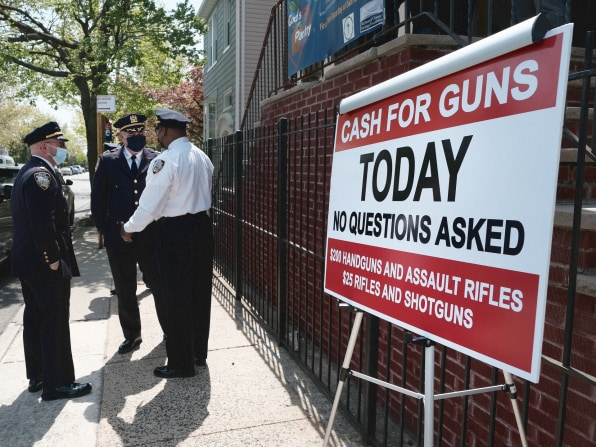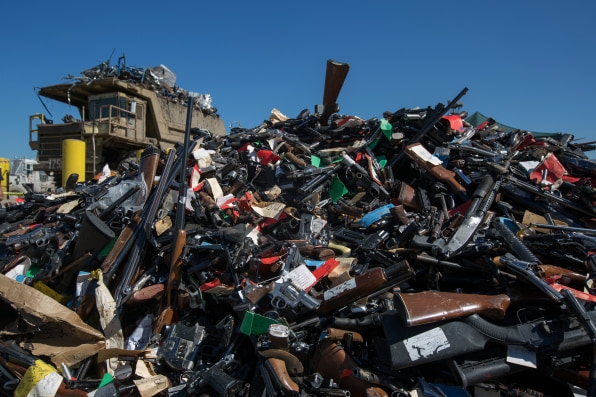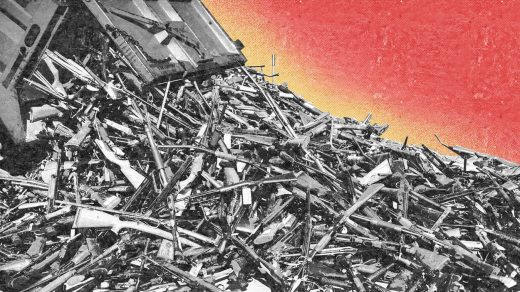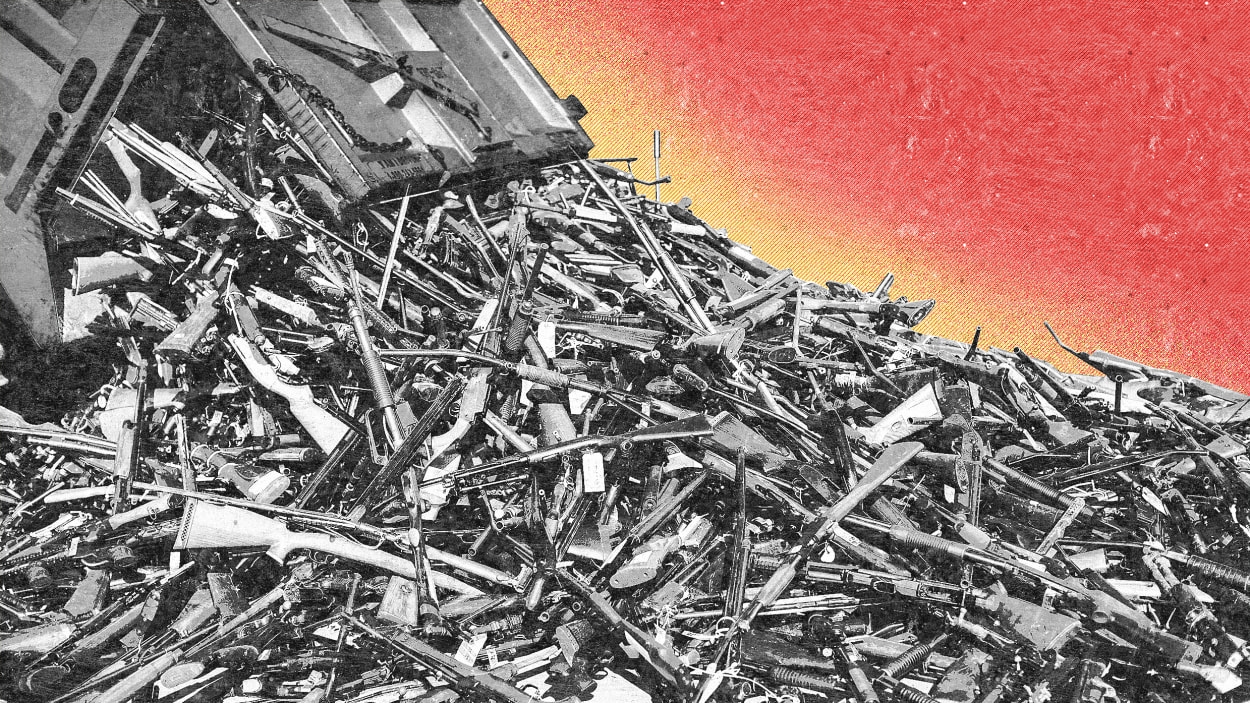Gun buybacks are happening across the country. But do they work?
On a wet Saturday morning in late August, the city of Raleigh, North Carolina, held its first-ever gun buyback event in a church parking lot. “It was raining, so we said, for sure nobody’s going to come out to this,” says Estella Patterson, the city’s chief of police. But shortly after the event kicked off at 9 a.m., lines spilled back onto the main road; 150 people in total came in, some waiting for hours, to voluntarily drop off 278 pistols, rifles, and even an AK-47, to eventually be stored securely or destroyed. “The response was overwhelming,” she says.
It was one of many gun buybacks in U.S. cities that week, including ones in Chicago and Houston, all of which also reported successful turnouts and praise from the public. The logic seems sound: They result in fewer firearms on the streets at a time of rising gun violence, and with nearly 400 million guns circulating in the country.
But studies have consistently shown that buybacks have little effect as a gun-violence-prevention method because they primarily encourage responsible citizens to turn in old or unwanted guns, rather than criminals who use them to commit violence. Some experts say they could be more effective if they targeted high-crime areas or increased economic incentives—but most say it makes more sense to redirect limited resources to other programs.

[Photo: Spencer Platt/Getty Images]
Gun buybacks in America refer to events that people voluntarily attend to surrender their firearms for destruction, with no questions asked and no need for ID, in return for cash or vouchers. The first was held in Baltimore in 1974 (though historians point out that officials collected weapons in exchange for gold during the Spanish-American war, which was effectively a buyback). Since then, they’ve been touted by politicians, including Presidents Clinton and Biden, and cities have done them sporadically. They saw a resurgence after the 2019 mass shootings at a Walmart in El Paso, Texas, and at a bar in Dayton, Ohio. Dozens of buybacks took place in 2021, from Philadelphia to Albuquerque.
There was another flurry in August this year, as part of a week of crime-targeting initiatives by 24 Democratic mayors across the country. Houston collected 845 guns, Richmond, Virginia, collected 474—and had to end early due to more participants than anticipated. Richmond Mayor Levar Stoney said the motivation was to reduce the availability of guns and create a safe space in which people could transfer over their weapons. “I would say that the gun buyback was successful because we know that every gun voluntarily turned over is one less gun that can be involved in gun violence,” he says. “And we know that we have way too many damn guns—not just in our city, but also across this country.”
The U.S. has seen a widespread rise in gun violence—in many cases to historic highs. Richmond had 90 homicides in 2021, the highest number in 15 years. Houston’s murder rate was 71% higher in 2021 than 2019, and 2021 was Chicago’s deadliest year in a quarter century. In Raleigh, 69 people have been shot in the first half of 2022, and more killed than in the two years prior. Patterson, the police chief, also mentions 270 reports of guns being stolen in Raleigh this year.
Tackling those concerning statistics seems like a valid reason for conducting gun buybacks. But, because they’re voluntary, they tend to attract law-abiding gun owners and people who no longer wanted to possess weapons. The mayors of Richmond and Raleigh both said that turnout was overwhelmingly dominated by people who’d inherited guns from family members but didn’t want them in their homes, especially around children or grandchildren—an important consideration. given that every year in the U.S., 350 children accidentally shoot themselves or another person. “They were thanking us for giving them a place to safely deposit these weapons,” says Raleigh Mayor Mary-Ann Baldwin.
Often, the guns collected are old and obsolete, and some no longer take modern ammunition. Raleigh’s event brought in 11 inoperable guns, plus Airsoft and BB rifles. “It’s almost equivalent to a special garbage collection day when you can turn in appliances and electronics,” says David Kennedy, a professor of criminal justice at John Jay College of Criminal Justice in New York City. Those don’t fit the descriptions of the guns most used in crimes, he says, which are newer, higher quality and caliber, and semiautomatic handguns more than “ancient” revolvers or shotguns.
In the past, the buyback exchange has also been a tactic for people to give away older guns and use the cash to buy new guns. But to avoid that during this round of buybacks, the cities instead offered gift cards. Raleigh, for instance, paid out Costco gift cards in the sum of $150 for a handgun, $100 for a rifle, and $200 for an assault rifle.
A recent study from the National Bureau of Economic Research (NBER) that analyzed the effects of several buybacks over a long period revealed that rates of gun deaths didn’t decrease after these events—including suicides. Potential reasons were that the economic incentives aren’t high enough, being far short of the market value for guns (which usually cost between $400 and $800); that people buy new guns with the cash; and that criminals may actually be spurred to commit crimes because they know responsible citizens are relinquishing their guns. Generally, buybacks have a small effect on local supply (14 guns per 100,000 people), and they’re narrow in scope, usually targeting specific neighborhoods within cities.

[Photo: David McNew/Getty Images]
“These buyback programs keep getting pushed and are seemingly the popular city-level policy right now,” says Mark Anderson, a coauthor of the working paper and professor of economics at Montana State University, “when there’s scant evidence that they’re effective.” Kennedy, the criminal justice expert, is even harsher in his critique. “I don’t think anybody who’s studying buybacks will say they’re completely useless,” he says. “They’re just almost completely useless.”
Still, cities seem set on doing them. Kennedy says the idea of getting guns off the streets makes common sense to the public. And, it may come from a sense of desperation among local officials, when their state lawmakers aren’t taking action on gun control measures like universal background checks and banning assault rifles. “People feel the need to do something,” he says. “And this is something.” In general, it’s not a policy prioritized by national gun control groups, though Patterson says Moms Demand Action volunteers were partners in the Raleigh buyback.
For Anderson, there’s another possible reason for their popularity. “The visual aspect of gun buyback programs can be a seemingly great PR campaign,” he says, with the images of tables and warehouses full of firearms, and then getting destroyed. Guns are usually crushed or melted down and the metal is recycled, turned into gardening tools, or made into artwork, as will be the case in Richmond. North Carolina is one of at least 12 states where Republican legislators have passed laws forbidding the destruction of collected weapons, so Patterson will have to petition the court for permission; otherwise they’ll have to store them in the police department.
Raleigh, Richmond, and Houston are planning on hosting gun buyback events again. Mayors say they’re also beneficial for raising awareness, and for forging much-needed bonds between communities and their police forces. They will be done in tandem with other violence-prevention programs, such as educating on safe gun storage, hiring violence interrupters, and investing in after-school programs for children and teenagers to steer them away from bad influences. “We recognize that we have to be tough on crime, but we have to be tough on the root causes of crime as well,” Stoney says.
If cities are intent on holding the buybacks, the research says there may be ways to improve their efficacy. In the NBER study, Anderson suggests that they may be more impactful if concentrated in higher-crime areas, or if they offer bigger economic incentives. But ultimately, he says there’s probably a better use of resources elsewhere, such as educating the public on best practices for safe storage, and promoting legislation that mandate those safe storage methods. Those decisions are especially important when local funding is limited. Raleigh’s buyback cost $30,000; Richmond’s cost at least $100,000, and was taken from $500,000 of American Rescue Plan to place toward anti-violence initiatives.
Kennedy is less sympathetic to the idea of buybacks in any form. “The money and energy that goes into them is essentially wasted,” he says. “[Cities] think they’re doing something useful. And they’re not.” He believes the only way buybacks could hypothetically make a difference is if they were mandatory—like the one rolled out in Australia after a 1996 mass shooting that bought back 640,000 firearms, 20% of the country’s guns. But “no such thing is remotely possible in the U.S.,” Kennedy says. Even the mere suggestion tanked Beto O’Rourke’s presidential campaign in 2020. Anderson agrees, mentioning the irony: “We don’t like to be told what to do,” he says. “But then it’s that very voluntary nature that probably renders these things pretty ineffective.”
Richmond’s Stoney isn’t blind to the limitations of buybacks. “We don’t believe it’s a panacea, but we believe this is one strategy to reduce the availability of firearms,” he says. He knows that things like background checks and and limiting military-style weapons would be more useful, but his city council doesn’t have the power to pass that kind of legislation. “If the state and federal lawmakers will step up,” he says, “I guarantee you it will save lives and communities like mine.”
(27)



